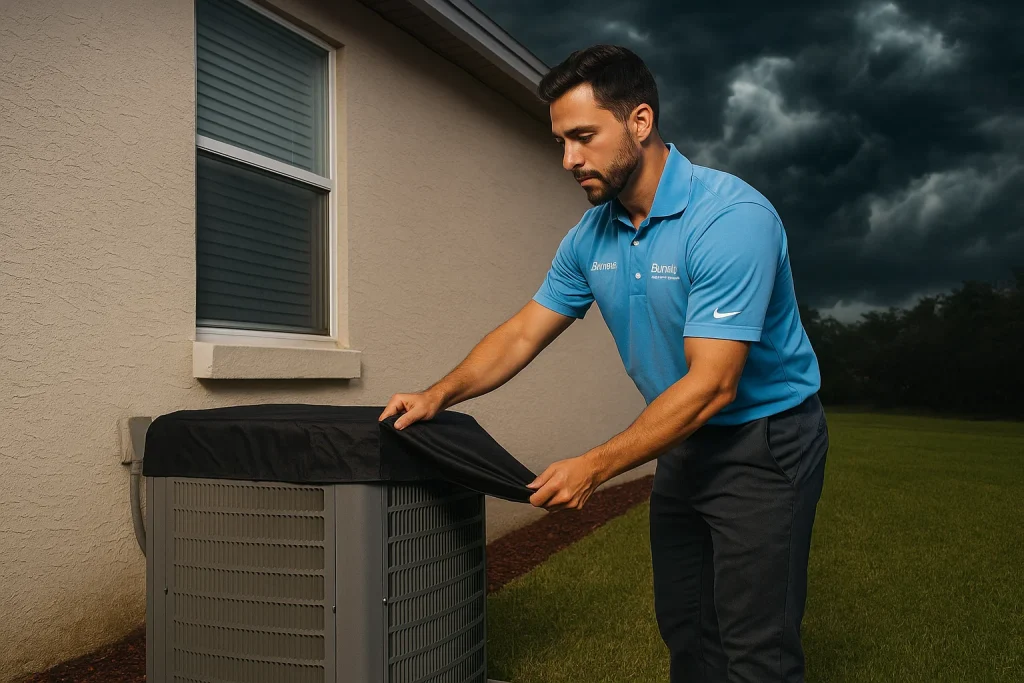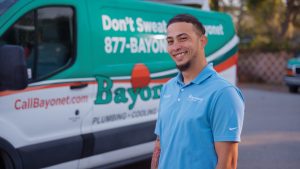Tropical storms and hurricanes are an unavoidable part of life in Florida. While most homeowners know to stock up on essentials and secure their property, many overlook one of the most important systems in their home: the HVAC system. High winds, heavy rain, and power surges can cause significant damage if your system isn’t properly protected. Let’s go through the essential steps to prepare your HVAC system before a storm and what to do after it passes.

Steps to Protect Your HVAC System Before a Storm
1. Secure Outdoor Units
Your outdoor condenser should be firmly anchored to its base. Check to make sure the bolts are tight and the unit is stable. Consider adding hurricane straps or brackets for extra security. This is something our team can help with if you’re not comfortable securing your condenser unit.
2. Power Down the System
Before the storm arrives, turn off your HVAC system at the breaker. Power surges are one of the most common causes of storm-related HVAC damage, and shutting off the system can help protect expensive components like compressors and control boards.
3. Cover the Unit Safely
Use a manufacturer-approved cover or a weather-resistant tarp to shield the outdoor unit from flying debris and heavy rain. Be sure to secure the cover so it won’t blow away, and never run your system while it’s covered. A proper cover helps keep debris out but still allows for airflow, which reduces the risk of corrosion or trapped moisture.
4. Clear the Area
Take a few minutes to remove any lawn furniture, planters, toys, or loose landscaping items near the outdoor unit. During a hurricane, these can easily become airborne and cause serious damage.
Post-Storm HVAC Recovery Tips
Once the storm has passed, resist the urge to flip your HVAC system back on right away. Taking a few precautionary steps can help prevent further damage.
1. Inspect the Unit Before Restarting
Look for signs of flooding, dented panels, disconnected wiring, or debris. If the unit has been submerged, do not turn it on — call a professional immediately.
2. Remove Covers and Debris
If you used a tarp or cover, take it off before powering up the system. Remove any leaves, sticks, or other debris to ensure the unit has proper airflow.
3. Replace or Clean the Air Filter
Your air filter may have collected excess moisture or debris during the storm. A clean filter helps your system work efficiently and protects indoor air quality.
4. Watch for Warning Signs
When you do turn the system back on, pay close attention to how it runs. Unusual noises, weak airflow, or smells like vinegar can signal moisture damage or other issues that need to be addressed quickly.
5. Schedule a Professional Inspection
Even if everything seems fine, hidden storm damage can worsen over time. Our team can spot problems before they turn into expensive repairs and ensure your system is operating safely and efficiently.
If you need professional help preparing or inspecting your system after a storm, we are here to help. Our experienced team is ready to keep your home comfortable, no matter what the weather brings.
It’s No Sweat: Call Bayonet! Contact Bayonet Plumbing, Heating & Air Conditioning to schedule an AC inspection in Venice Gardens, FL today!

